CIVIDALE DEL FRIULI
Patriarchal Palace
THE PATRIARCHAL PALACE under the MUSEO ARCHEOLOGICO NAZIONALE
The archaeological area is located in the Museum basement (area A: stratification refers to the remains of the Patriarch’s Palace of the Longobard period and to the later late medieval phases), and on the building’s south side (area B: stratification refers to the development of an area of habitation within the city’s late antique and medieval context), its walls are generally well preserved as to the stone, pebble and brick structures.
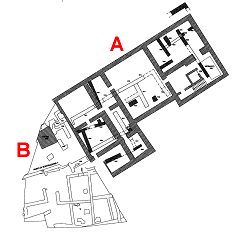 Plan of the Patriarchal’s Palace remains |
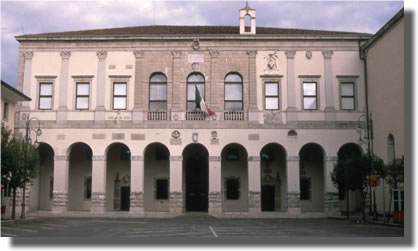 Palazzo dei Provveditori Veneti, designed by Andrea Palladio |
Some structures belonging to the Patriarchal Palace have survived and are visible in the lowest level of the Museo Archeologico Nazionale, and likewise, a well still today bearing the name of Well of Callixtus, survives in an area behind the apse of the Duomo.
The Palace structures were brought back to light in the 1970, and belong to two phases: the first belongs to the Early Middle Ages, while the second one belongs to a Late Medieval or Renaissance phase.
- REMAINS OF THE PATRIARCHAL PALACE
- THE NATIONAL ARCHAEOLOGICAL MUSEUM
- LONGOBARD ARCHAEOLOGICAL REMAINS
- TOMB OF GISULF
- GOLDEN CROSSES AND COINS COLLECTION
- HISTORICAL ARCHIVES AND LIBRARY
REMAINS OF THE PATRIARCHAL PALACE
In the Early Medieval masonry it is easy to see what remains of the Longobard Patriarchal Palace mentioned by Paul the Deacon. Probably Callixtus chose to take up residence in a pre-existing Palace -built by Bishop Amator perhaps upon late roman structure - which Callixtus restructured or totally rebuilt.
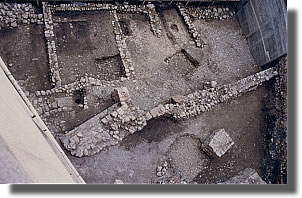

Structures referring to Patriarchal Palace and axonometry of the remains
under the Palazzo dei Provveditori Veneti (today’s Museo Archeologico Nazionale)
The building was erected on one side of the Basilica of Santa Maria; its wall masonry consisted of large river pebbles bound with mortar, and it had a square plan and may have been equipped with a solarium on the first floor.
It is still possible admire part of the original decoration, a mosaic floor comprising of geometrical patterns picked out in black tesserae, against a white background. The mosaic can be compared to the paving of the early christian episcopal seat in Aquileia, which belongs to the end of the 4th or the beginning of the 5th century; the mosaic in Cividale is thus considered a late imitation of the one in Aquileia.
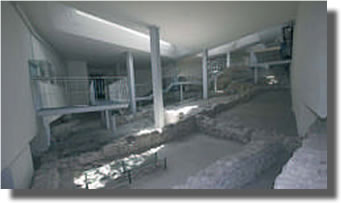
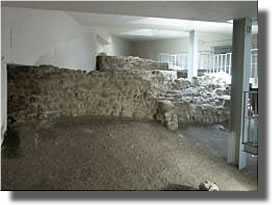
The Palace is described by Late Medieval sources as a large building including many halls and a chapel dedicated to Saint Paulinus of Aquileia, and overlooking a large open area, described as a viridarium (“garden”), where, as situated in aere prope palatium e post ecclesiam maiorem (“in the area close to the palace and behind the main church”) with a well, which still exists, and whose memory is recorded also by the local place names.
The recent excavations (1987 – 1988) have shown that the Episcopal complex near the Basilica had been built close to an area inhabited from the 3rd to the 5th century, after which its structures were reused in the Longobard period, during phases which may date to the 6th or 7th centuries, which is also the date of certain inhumation burials found there.
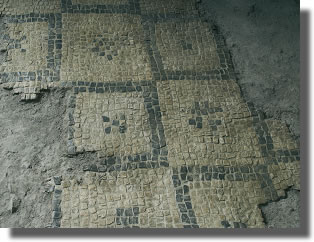
Mosaic inside the Patriachal Palace
In this context, which exemplifies the development of a city neighbourhood between the Late Antique and the Early Medieval period, this area has been inserted in the visitors’ route, as a roofed archaeological annexed to the Archaeological Museum.
Over the remains of the Patriarch’s Palace which was mostly destroyed by the earthquake of 1511, the so-called Palazzo dei Provveditori Veneti was built following plans of Andrea Palladio, between 1565 and 1596.
THE NATIONAL ARCHAEOLOGICAL MUSEUM
This building is today the site of the Museo Archeologico Nazionale (National Archaeological Museum). The Museum is home to almost all archaeological finds excavated in Cividale and in its surrounding areas from the early 19th century, when a canon, count Michele della Torre Valsassina, embarked on the first methodical archaeological excavation.The finds range from the early palaeolithic up to modern times.
In the roman lapidarium are placed architectural elements and epigraphy monuments which form the base for the historical reconstruction and the administrative and urban organization of Forum Iulii.
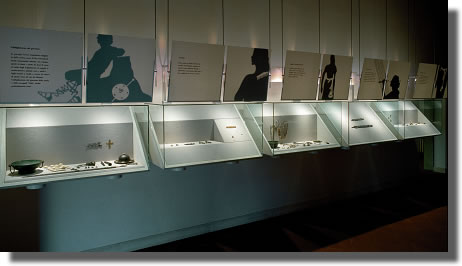
The Early Medieval lapidarium, recently enhanced by new didactic materials, preserves many fragments of sculpture belonging to the liturgical field, and which testify the architectural wealth of the many religious buildings extant in Cividale between the 6th and the 9th century (namely, the Basilica of Santa Maria Assunta, San Giovanni in Valle, the Tempietto Longobardo, Santa Maria di Corte and San Salvatore).
Their presence allows us to follow the stylistic development of Cividale’s early medieval sculpture from the early christian period up to the carolingian.
In the romanesque section there are many sculptural element which must have formed part of the architectural decoration of the Patriarch’s Palace after the building was enlarged in the 13th century.
LONGOBARD ARCHAEOLOGICAL REMAINS
The most interesting section, which ranks at an impressive second place due to its importance, is the one exemplifying Longobard funerary archaeological remains.
The exhibition includes the main funerary furnishings, which have been reconstructed where possible in their entirety, and which belong to suburban necropolises (San Mauro, Santo Stefano in Pertica, Cella, San Giovanni, Ferrovia, Piazza della Resistenza), or to burials within the urban area, as well as some furnishings from other early medieval necropolises of the duchy of Friuli and of the duchy of Ceneda.

The exhibition layout has been designed to ensure maximum appreciation of the main treasures produced by the artistic handicraft of the Longobards, while also highlighting the many aspects of ritual and of Longobard society.
The funerary complexes of Santo Stefano in Pertica and San Mauro stand out for their importance and richness, and are the result of recent excavations carried out by the Soprintendenza per i Beni Archeologici del Friuli Venezia Giulia.
TOMB OF GISULF
The so-called “Tomb of Gisulf”, a monument of quite exceptional character, was found in Cividale during the 19th century in piazza Paolo Diacono, not far from the ruins of the imposing late imperial palace.
The tomb contains the remains of a wealthy courtier of the 7th century, which had been placed in a sarcophagus sealed by a stone slab.
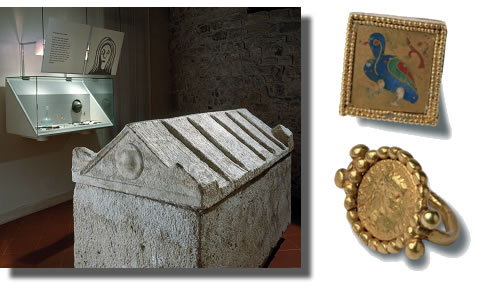
The complex is a unique specimen of its kind, and can be compared to the burials of aristocrats of ducal or royal blood, as also the highly wealthy furnishings which comprise some elements which symbolize the exalted rank of the deceased, e.g., a signet ring containing a gold coin dating to the time of emperor Tiberius, a cross in gold lamina and semi-precious stones, unparalleled in the italian peninsula, and a small encrusted with polychrome enamel. in all the exhibition section covering Longobard funerary archaeology, it is easy to chart the evolution of clothing, of handicraft, of daily life of Longobards in Cividale and in Friuli, from their arrival in Italy until the end of the 7th century.
In the most ancient women’s tombs a custom still prevails by which four typical fibulae (brooches) placed in the burial, two of which are s-shaped and two are shaped like a stirrup, according to the traditions of Pannonia; on the other hand, female burials of the 7th century illustrate the gradual introduction of techniques and fashions from the Mediterranean world, derived from the Byzantine world, where large brooches take the place of the small shaped ones.
GOLDEN CROSSES AND COINS COLLECTION
The Museum holds a collection of golden crosses, which are exceptional in both number and richness, and which are typical of funerary furnishings of Longobards in Italy, appearing in both male and female, in adult and child burials. These are specifically funerary objects, which the Longobards begun using by imitating a custom typical of the Mediterranean area, in which such crosses were sewn on to a veil and indicated the deceased was a christian.
Many bronze containers, real luxury objects placed in tombs of people of consequence, testify to the early medieval long range trading routes, which started in the Mediterranean basin and reached Germany and the Rheinish region via Italy.

Significantly, golden and silver coins also came to light in the necropolises, thus documenting the first minting efforts of the Longobards of the duchy of Friuli.
An extraordinary collection of gold coins, the second in rank in the whole world for its importance, and acquired on the antiquarian market, includes 56 golden coins, some being of a type of coin called tremissis and others being coins called solidi; these were mostly coined in the mints of Ticinum-Pavia and Benevento, and date from the second half of the 6th century to the first years of the 9th century.
HISTORICAL ARCHIVES AND LIBRARY
The last floor of the Museum houses the Archives and Library where ancient library and documental collections are kept, and can be consulted by the general public. these come from ecclesiastical, civil and
monastic institutions of Cividale, mostly founded during Longobard rule.
The richest collection belongs to the prestigious Chapter of the Collegiata of Santa Maria Assunta, which had been endowed during the centuries by Pontiffs and Patriarchs, being presented with large donations and many privileges and with the ownership of the Benedictine Monastery of Santa Maria in Valle.
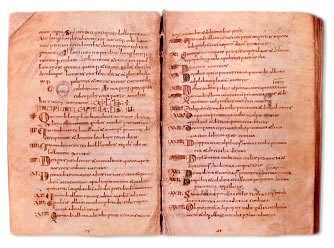
One of the latest copies of Paul Deacon’s “Historia Langobardorum”
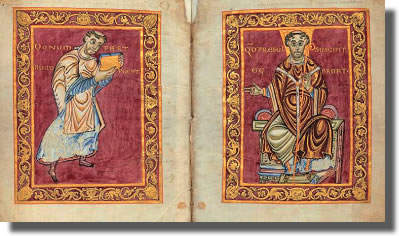
“Salterium Egberti”, UNESCO Memory of the World
An extraordinary nucleus, including over a hundred handwritten codexes stands out, being exceptional in its entirety, and because of a few items of unequalled value: among most important elements is a copy of Paul the Deacon’s Historia langobardorum, one of the most ancient copies of this work, as it dates to the 9th century.
Other great highlights include a Psalterium Egberti – part of a corpus of manuscripts from Monastery of Reichenau -already part of UNESCO World Heritage- and a Psalter of Saint Elizabeth.
In the Museum is also the Archivio Storico del Museo Archeologico (the Historical Archives of the Archaeological Museum), which includes the “Fondo Michele della Torre Valsassina 1817-1844”, a collection comprising of manuscripts and albums of drawings which are still partly unpublished, which are particularly important in documenting the archaeological excavations carried out at the beginning of the 19th century at Cividale and in its surroundings, and the first Longobard burials to be found and documented.
Lastly, the Museum is home to works of art (such as jewellery, textiles and paintings on wood panels and on canvas), of exceptional artistic value, which formed part of the treasury collections of the city’s main religious institutions and are now being transferred to a new Museum that is being set up, called “Museo d’Arte Antica di Palazzo de’ Nordis” (Ancient Art Museum of Palazzo de’ Nordis).
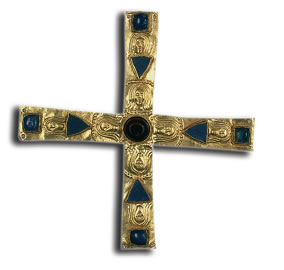
Among the most ancient pieces is a large cross in silver lamina from Santa Maria in Valle, dating to the second half of the 8th century, which recalls the cross of Desiderius of the Monastery of San Salvatore in Brescia and the so-called “Pace” (“Peace”) of Duke Orso, a precious covering for a Book of the Gospel, made of wood, ivory, silver semiprecious stones, mother of pearl, which was re-used as a “pace”, which can be dated to a time between the 8th and the 9th century.






